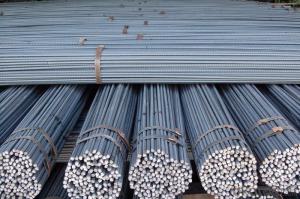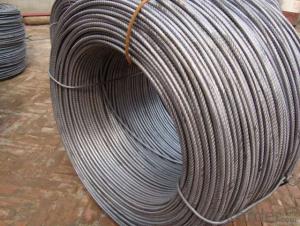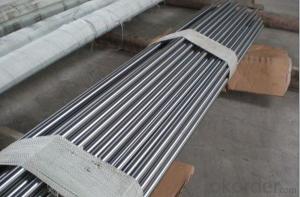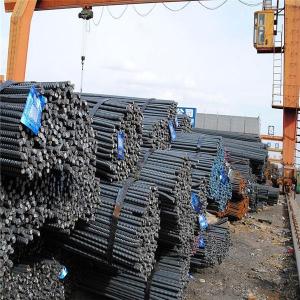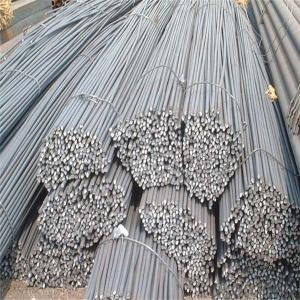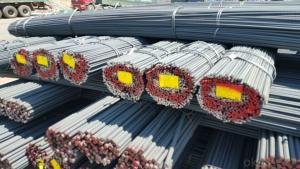High Quality GB Standard Deformed Steel Rebar HRB400
- Loading Port:
- China main port
- Payment Terms:
- TT or LC
- Min Order Qty:
- 50 m.t.
- Supply Capability:
- 100000 m.t./month
OKorder Service Pledge
OKorder Financial Service
You Might Also Like
Specifications of High Quality GB Standard Deformed Steel Rebar HRB400
Standard | GB | HRB400 | |
Diameter | 6mm,8mm,10mm,12mm,14mm,16mm,18mm,20mm, 22mm,25mm,28mm,32mm,36mm,40mm,50mm | ||
Length | 6M, 9M,12M or as required | ||
Place of origin | Hebei, China mainland | ||
Advantages | exact size, regular package, chemical and mechanical properties are stable. | ||
Type | Hot rolled deformed steel bar | ||
Brand name | DRAGON | ||
Chemical Composition of High Quality GB Standard Deformed Steel Rebar HRB400
(Please kindly find our chemistry of our material based on HRB500 as below for your information)
Grade | Technical data of the original chemical composition (%) | ||||||
C | Mn | Si | S | P | V | ||
HRB400 | ≤0.25 | ≤1.60 | ≤0.80 | ≤0.045 | ≤0.045 | 0.04-0.12 | |
Physical capability | |||||||
Yield Strength (N/cm²) | Tensile Strength (N/cm²) | Elongation (%) | |||||
≥400 | ≥570 | ≥14 | |||||
Theoretical weight and section area of each diameter as below for your information:
Diameter(mm) | Section area (mm²) | Mass(kg/m) | Weight of 12m bar(kg) |
6 | 28.27 | 0.222 | 2.664 |
8 | 50.27 | 0.395 | 4.74 |
10 | 78.54 | 0.617 | 7.404 |
12 | 113.1 | 0.888 | 10.656 |
14 | 153.9 | 1.21 | 14.52 |
16 | 201.1 | 1.58 | 18.96 |
18 | 254.5 | 2.00 | 24 |
20 | 314.2 | 2.47 | 29.64 |
22 | 380.1 | 2.98 | 35.76 |
25 | 490.9 | 3.85 | 46.2 |
28 | 615.8 | 4.83 | 57.96 |
32 | 804.2 | 6.31 | 75.72 |
36 | 1018 | 7.99 | 98.88 |
40 | 1257 | 9.87 | 118.44 |
50 | 1964 | 15.42 | 185.04 |
Usage and Applications of High Quality GB Standard Deformed Steel Rebar HRB400
Deformed bar is widely used in buildings, bridges, roads and other engineering construction. Big to highways, railways, bridges, culverts, tunnels, public facilities such as flood control, dam, small to housing construction, beam, column, wall and the foundation of the plate, deformed bar is an integral structure material. With the development of world economy and the vigorous development of infrastructure construction, real estate, the demand for deformed bar will be larger and larger..
Packaging & Delivery of High Quality GB Standard Deformed Steel Rebar HRB400
Packaging Detail: products are packed in bundle and then shipped by container or bulk vessel, deformed bar is usually naked strapping delivery, when storing, please pay attention to moisture proof. The performance of rust will produce adverse effect.
Each bundle weight: 2-3MT, or as required
Payment term: TT or L/C
Delivery Detail: within 45 days after received advanced payment or LC.
Label: to be specified by customer, generally, each bundle has 1-2 labels
Trade terms: FOB, CFR, CIF
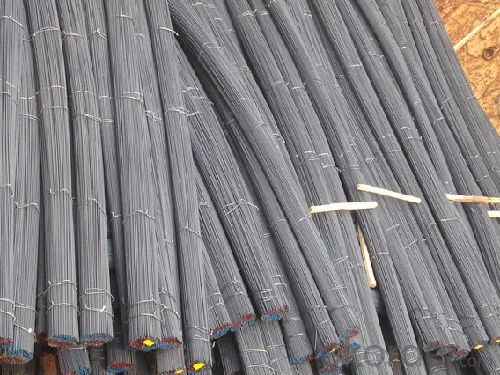
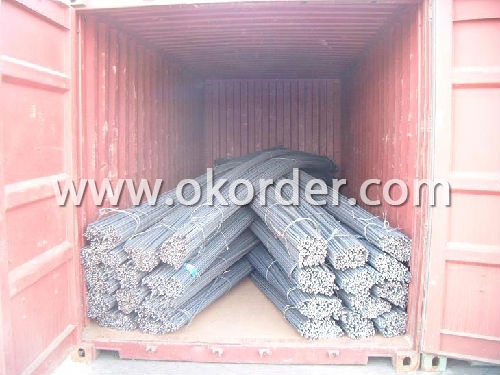
Deformed Steel Bar in factory
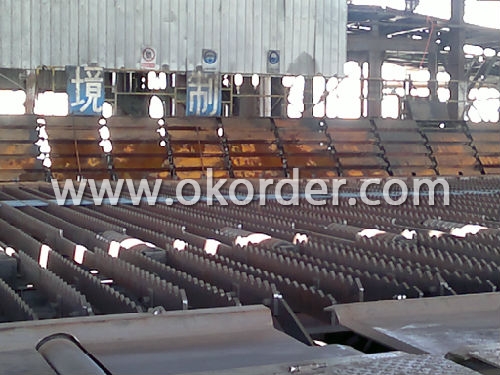
Note:
1. Our products are produced according to national standard (GB), if not, supply according to national standards (GB) or agreement as customer required.
2. Other Grade and Standard Deformed Steel Bar we can supply:
Grade: GR40/GR60, G460B/B500A/B500B/B500C,BST500S
Standard: ASTM, BS, DIN
The Minimum Order Quantity of these products is high, and need to be confirmed.
3. We can not only supply Deformed Steel Bar; if you need anything about building materials, please contact us for further information.
4. Please send us your detail specifications when inquire. We will reply to you as soon as possible. We sincerely hope we can establish a long stable business relationship.
- Q: What is the process of deforming steel rebars for better adhesion with concrete?
- The process of deforming steel rebars for better adhesion with concrete is known as ribbing or rib deformation. This process involves creating small ridges or raised patterns along the surface of the rebar, which enhances the bond between the concrete and the steel. The ribbing process is typically performed through a mechanical operation called cold rolling. Cold rolling is a metalworking process where the steel rebar is passed through a series of rollers, which exert pressure on the surface and cause plastic deformation. The rollers are designed with specific patterns or configurations that create the desired ribbing on the rebar. The purpose of ribbing is to increase the surface area of the rebar in contact with the concrete. The ridges or patterns created by the ribbing process provide additional points of adhesion for the concrete to grip onto, significantly improving the bond strength between the two materials. This enhanced bond is crucial for reinforcing concrete structures, as it helps to distribute loads and resist tensile forces. The ribbing process is commonly used in the construction industry for reinforcing concrete structures such as beams, columns, and slabs. The specific pattern and depth of the ribbing may vary depending on the project requirements and the type of rebar being used. Manufacturers often adhere to industry standards and guidelines to ensure the proper design and placement of ribbed rebars. In summary, the process of deforming steel rebars for better adhesion with concrete involves ribbing or creating ridges on the rebar's surface. This is achieved through cold rolling, where the rebar is passed through rollers designed with specific patterns. Ribbing increases the surface area and provides additional points of adhesion, improving the bond between the concrete and the rebar.
- Q: How are steel rebars stored and transported?
- Construction projects commonly use steel rebars, which are also known as reinforcing bars. The purpose of steel rebars in construction is to provide strength and stability to concrete structures. It is vital to properly store and transport steel rebars to maintain their quality and prevent any damage or accidents. Regarding storage, steel rebars are typically kept in a designated area known as a rebar yard or laydown yard. This area should be clean, well-drained, and free from debris or organic materials. To prevent corrosion or contamination, rebars are usually stacked in bundles or placed on elevated racks to avoid contact with the ground. To ensure safety and easy access, rebars should be organized and labeled based on their sizes and grades. This helps construction workers quickly identify and retrieve the required rebars without causing any disruption or delays in the project. When it comes to transportation, steel rebars are commonly loaded onto trucks or trailers for delivery to construction sites. It is crucial to secure the rebars adequately during transportation to avoid any shifting or movement that could damage the rebars or compromise the safety of the vehicle. Depending on their length and quantity, rebars can be transported in various ways. They can be bundled together using wires, straps, or steel bands to keep them in place. Additionally, wooden or metal supports can be used to prevent the rebars from bending or sagging during transit. During transportation, it is important to consider weight restrictions and road regulations to ensure compliance and safety. If rebars need to be transported over long distances, it is essential to coordinate with logistics companies that specialize in handling heavy and oversized cargo. In conclusion, steel rebars are stored in designated areas like rebar yards, where they are stacked, labeled, and protected from corrosion and contamination. During transportation, rebars are secured using wires, straps, or steel bands and loaded onto trucks or trailers. Proper handling and adherence to regulations are crucial to ensure the safety and integrity of the rebars during storage and transportation.
- Q: Can steel rebars be used in marine environments?
- Yes, steel rebars can be used in marine environments, but they need to be properly coated or made from corrosion-resistant materials (such as stainless steel) to prevent rusting and degradation caused by saltwater exposure.
- Q: What is the recommended spacing between inclined steel rebars in slabs?
- The recommended spacing between inclined steel rebars in slabs typically depends on the specific design requirements and load conditions. However, a common guideline is to maintain a spacing of at least 3 times the diameter of the rebar. This ensures proper structural integrity and helps distribute the load evenly across the slab. It is important to consult with a structural engineer or refer to relevant building codes and standards for precise spacing recommendations based on the project's specifications.
- Q: How do steel rebars provide reinforcement to concrete?
- Steel rebars provide reinforcement to concrete by adding strength and durability to the structure. When embedded within the concrete, rebars act as tension members, resisting forces that would otherwise cause cracking or failure. The high tensile strength of steel rebars helps to distribute and absorb load, enhancing the overall structural integrity of the concrete.
- Q: How are steel rebars protected against mechanical damage during construction?
- Steel rebars are protected against mechanical damage during construction through various methods. One common method is by using protective covers or sleeves made of materials such as plastic or rubber. These covers are placed over the rebars to create a physical barrier, preventing them from being directly exposed to potential sources of damage, such as heavy machinery or construction equipment. Another method of protection is by using rebar caps or safety caps. These caps are designed to fit over the ends of the rebars, providing an extra layer of protection against mechanical damage. They help to prevent the rebars from being bent, crushed, or damaged by accidental impacts. In addition to physical protection, rebars can also be protected against mechanical damage through proper storage and handling. It is important to store rebars in a designated area that is free from any potential sources of damage, such as sharp objects or heavy materials. When handling rebars, workers should use proper lifting techniques and avoid dragging them on rough surfaces, as this can cause scratches or other forms of damage. Furthermore, during construction, rebars are often inspected regularly to ensure that they are not damaged or compromised. Any rebars that show signs of damage, such as bends, cracks, or deformations, are typically replaced to maintain the structural integrity of the construction project. By implementing these protective measures, steel rebars can be safeguarded against mechanical damage during construction, ensuring their effectiveness in providing strength and reinforcement to the structures they are used in.
- Q: Can steel rebars be prefabricated off-site?
- Absolutely, steel rebars can be manufactured off-site through the process of prefabrication. This method involves creating construction components in a controlled environment that is separate from the actual construction site. Steel rebars, which are frequently used to reinforce concrete structures, can be fabricated off-site in a specialized facility. Prefabricating steel rebars off-site provides several advantages. Firstly, it enables a more efficient and streamlined manufacturing process. By working in a controlled environment, the rebars can be produced with great precision and accuracy, ensuring consistent quality. This reduces the likelihood of errors and minimizes wastage. Furthermore, manufacturing steel rebars off-site can save time during the construction phase. Since the rebars are manufactured beforehand, they can be delivered to the site ready for installation, eliminating the need for on-site fabrication. This significantly speeds up the construction process and improves project timelines as a whole. Moreover, prefabrication offers improved safety conditions. By manufacturing the rebars off-site, workers are exposed to fewer on-site hazards, such as working at great heights or in confined spaces. The controlled environment of a fabrication facility also allows for better quality control and compliance with safety regulations. Lastly, prefabrication contributes to cost savings. The efficient production process, reduced on-site labor, and improved construction timelines all help to lower overall project costs. Additionally, the controlled environment of a fabrication facility enables better utilization of materials and decreases wastage. In summary, steel rebars can indeed be prefabricated off-site, providing numerous benefits such as enhanced quality, time savings, improved safety, and cost-effectiveness. This practice is widely utilized in construction projects to optimize efficiency and ensure the highest standards of construction.
- Q: What is the lifespan of steel rebars in concrete structures?
- The lifespan of steel rebars in concrete structures can vary depending on several factors such as the quality of the steel, the environment in which the structure is located, and the level of maintenance. However, with proper design, construction, and maintenance, steel rebars in concrete structures can typically last for several decades to over a century.
- Q: What is the process of reinforcing existing concrete structures with steel rebars?
- Enhancing the strength and durability of existing concrete structures with steel rebars involves a series of steps. To begin, a thorough assessment of the concrete structure is conducted to determine its condition and identify areas in need of reinforcement. This involves inspecting the concrete for cracks, signs of degradation, or any other structural issues. Once the areas requiring reinforcement are identified, the next step is surface preparation. This involves cleaning the concrete surface to remove any loose debris, dirt, or contaminants that could hinder the bonding of the rebars with the concrete. Various methods, such as pressure washing or sandblasting, can be used for this purpose. Following surface preparation, the rebars are strategically placed within the concrete structure. The positioning and spacing of the rebars are crucial to ensure optimal reinforcement and structural integrity. This is typically accomplished by drilling holes or creating channels in the concrete where the rebars will be placed. Afterward, the rebars are inserted into the holes or channels, ensuring proper alignment and securing. The rebars are typically cut to the required length and bent into the desired shape to meet the specific reinforcement needs of the structure. Once the rebars are in place, they are anchored or secured to the existing concrete by various means. This can be achieved through the use of epoxy adhesive, mechanical anchors, or embedding the rebars into fresh concrete poured around them. Finally, the concrete is restored to its original condition, covering the rebars and creating a smooth and even surface. This may involve patching up any holes or channels created during the reinforcement process and finishing the surface to match the surrounding concrete. In conclusion, the process of reinforcing existing concrete structures with steel rebars necessitates careful planning, proper surface preparation, precise placement of rebars, secure anchoring, and appropriate finishing to achieve a strengthened and long-lasting structure.
- Q: How do steel rebars impact the durability of concrete structures?
- The durability of concrete structures is significantly influenced by steel rebars. Adding steel rebars improves the strength and overall performance of concrete, making it more resistant to various external forces and extending its lifespan. To begin with, steel rebars offer structural reinforcement to concrete structures. Concrete has relatively low tensile strength, making it susceptible to cracking and failure under tensile stresses. By incorporating steel rebars into the concrete, these stresses are effectively distributed throughout the structure, preventing the formation of cracks and enhancing its load-bearing capacity. This reinforcement ensures that the concrete structure can withstand the forces it experiences, whether from gravity, wind, earthquakes, or other external factors. Additionally, steel rebars play a vital role in corrosion prevention in concrete structures. Concrete is highly alkaline, creating a protective environment for embedded steel. However, factors like moisture exposure, chloride ions, and carbonation can break down this protective layer over time, leading to steel corrosion. Corrosion weakens the rebars and causes the surrounding concrete to crack and spall, compromising the structure's durability. By using steel rebars with appropriate coatings or stainless steel, the risk of corrosion is significantly reduced, enhancing the structure's longevity and durability. Furthermore, steel rebars contribute to the durability of concrete structures by providing dimensional stability. Concrete tends to shrink and expand due to temperature and moisture changes, which can result in cracking and deformation. Incorporating steel rebars helps minimize these movements by providing restraint and stabilizing the structure, preventing excessive cracking and maintaining its integrity over time. In conclusion, steel rebars play a crucial role in enhancing the durability of concrete structures. They provide structural reinforcement, prevent corrosion, and ensure dimensional stability. By incorporating steel rebars into concrete, structures become stronger, more resistant to external forces, and have an extended lifespan. This ultimately leads to safer and more durable buildings and infrastructure.
Send your message to us
High Quality GB Standard Deformed Steel Rebar HRB400
- Loading Port:
- China main port
- Payment Terms:
- TT or LC
- Min Order Qty:
- 50 m.t.
- Supply Capability:
- 100000 m.t./month
OKorder Service Pledge
OKorder Financial Service
Similar products
Hot products
Hot Searches
Related keywords















